#Wildcats Version 3.0
Text


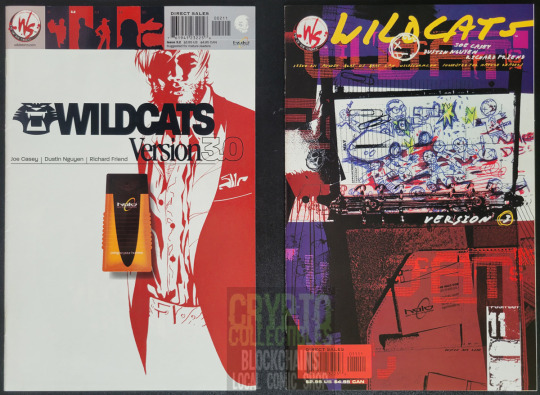

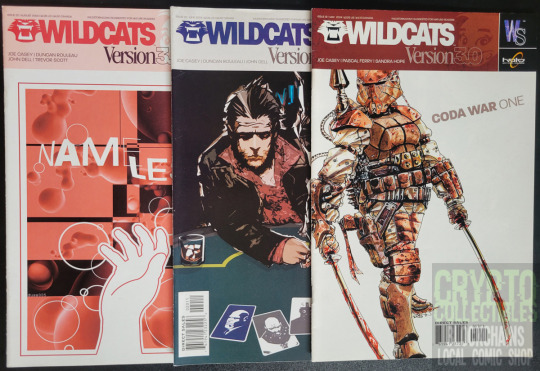
Wildcats Version 3.0 9 Issue Lot, Includes First and Last Issue (2002) by Wildstorm
Written Joe Casey and drawn by various.
#Wildcats#Wildcats 3.0#Wildcats Version 3.0#2002#Wildstorm#Joe Casey#Rian Hughs#Dustin Nguyen#Etsy#Vintage Comics#Comic Books#Comics#Grifter#Halo#Sam Garfield#John Dell#2003#2004
0 notes
Text
Zealot/Lady Zannah of Khera reading guide
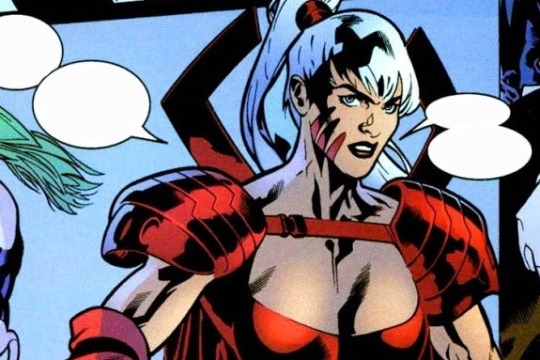
Lady Zannah is a high-ranking member of the CODA Sisterhood, a women-only group of warriors and a very influential party in the Kheran government.
After being stranded on Earth, Zealot created her version of the CODA, training women on the kherubim ways of war and fighting. After thousands of years of having a hand in many Historical events, Zealot (and Grifter) stepped out of the shadows and joined the WildC.A.T.S, a superhero team financed by the HALO Corporation and composed of descendants of the other kherubim living on Earth, to help fight in the war against the Deamonites.
Wildstorm Universe
-WildC.A.T.S (1992) #0 - #13
-WildC.A.T.S Trilogy (1993) #1 - #3
-WildC.A.T.S sourcebook (1993)
-Shadowhawk (1992) #13
-WildC.A.T.S (1992) #14 - #17
-Stormwatch (1992) #18
-Backlash (1992) #4
-WildC.A.T.S (1992) #18 - #19
Wildstorm Rising (1995) #1
Wildstorm Universe sourcebook (1995)
WildC.A.T.S (1992) #20
Union (1993) #4
Wetworks (1994) #8
Grifter (1994) #1
Backlash (1992) #8
Stormwatch (1992) #22
Wildstorm Rising (1995) #2
Spartan: warrior spirit (1995) #1 - #4
Voodoo/Zealot: skin trade (1995) #1
Zealot (1995) #1 -#3
WildC.A.T.S (1992) #22
Grifter (1995) #7 - #8
Spawn/WildC.A.T.S (1995) #1 - #4
Fire from Heaven (1995) #1
WildC.A.T.S (1992) #28 - #29
Backlash (1992) #20
WildC.A.T.S (1992) #30
Gen13 (1995) #11
Fire from Heaven (1995) #2
Deathblow (1993) #29
Shattered Image (1996) #2 -4
WildC.A.T.S (1992) #31 -34
Mars Attack Image
Grifter (1995) #9
WildC.A.T.S (1992) #35 - #37
Grifter (1995) #10
Backlash (1992) #31
WildC.A.T.S (1992) #38 - #40
JLA/WildC.A.T.S (1997)
X-Men/WildC.A.T.S (1997) #1 - 3
Wildcore (1997) #1 -2
Gen12 (1998) #2 & #5
Wildcats/Aliens (1998)
WildC.A.T.S (1999) #1 & #4 - #5
Wildcats: Mosaic (1999)
Wildcats (1999) #22 - #23 & #27
Wildcats version 3.0 (2002) #9, #13, #15, #19 - #21, #23 - #24
Wildcats: Nemesis (2005) #1 - #9
Majestic (2005) #8 - #17
Captain Atom: Armageddon (2005) #2 - 5
Wildcats (2006) #1*
Wildcats: Armageddon (2007) #1
Wildstorm Revelations (2007) #4 - #6
- DC/Wildstorm: Dreamwar (2008) #1 - #6
Number of the Beast (2008) #8
Wildcats (2008) #1
The Authority (2008) #1
Wildcats (2008) #2 - 18
The Authority (2008) #18
Wildcats (2008) #19 - #30
Prime Earth/Post Flashpoint
Deathstroke (2011) #9 - #13
Stormwatch (2011) #17 & #18
Batman: Urban Legends(2021) #4 - #6
Wildcats (2022) #1
Wildstorm 30th years anniversary (2022)
DC's Grifter got run over by a reindeer (2022) #1
Wildcats (2022) #3 -?
Recommended
The ones mentioned here are out of continuity
The Wild Storm (2017)
Superman vs Lobo (2021)
40 notes
·
View notes
Text
The Complete Authority Reading Guide

Born from the late 90s and early 00s trend towards darker superhero stories, The Authority debuted in 1999 with The Authority #1 by Warren Ellis and Bryan Hitch for WildStorm. The Authority fights for what they see as best for the world regardless of the cost. The Authority was one of DC’s best-selling books under Mark Millar and Frank Quitely. The team appeared in their series, as well as other WildStorm and DC titles. Their last appearance came months before the launch of DC’s The New 52. Since the N52, most Authority characters have been retconned or forgotten. Only the team’s breakout star Midnighter (and sometimes Apollo) remains active in comics.
This is a comprehensive guide to every appearance of The Authority's main characters: Jenny Sparks, Jack Hawksmoor, the Engineer (Angela Spica), the Doctor (Jeroen Thornedike, later Habib bin Hassan), Swift (Shen Li-Men), Apollo, the Midnighter, and Jenny Quantum.

Issues marked with an asterisk (*) don't feature Authority characters but do provide context.
Issues marked with New Button emoji (🆕) are newly added as of the most recent update. The emoji will be removed when the guide is updated again.
StormWatch
WildStorm was an independent studio established by Jim Lee in 1992. It was bought by DC Comics in 1998 and ran as an imprint until being shut down in 2010. Before The Authority debuted, there was StormWatch. StormWatch (1993) and StormWatch (1997) are the first appearances of most of the Authority’s original lineup.
StormWatch (1993-1997) — #28-31, #37-39, #42-44, #46, #48-50
StormWatch (1997-1998) — #4-12
WildC.A.T.s/Aliens (1998)*
The Authority
The Authority (1999) — #1-29
Wildstorm Summer Special (2001)
The Authority (2003) — #1-6
Coup D’Etat (2004) — #1-4
The Authority (2003) — #7-14
The Authority: Scorched Earth (2004)
The Authority: Human on the Inside (2004)
The Authority: Revolution (2004) — #1-12
Garth Ennis’s “Kev” tetralogy follows Kevin Hawkins, a terrible person with terrible luck, and his misadventures with the Authority. Where this series is in the chronology is unclear.
The Authority: Kev (2002) — #1
The Authority: More Kev (2004) — #1-4
The Authority: The Magnificent Kevin (2005) — #1-5
The Authority: A Man Called Kev (2006) — #1-5*
Solos
Jenny Sparks: The Secret History of the Authority (2000) — #1-5
Secret History of the Authority: Hawksmoor (2008) — #1-7
Midnighter (2007) — #1-20
Grifter and Midnighter (2007) — #1-6

Crossovers and Events
World War III was part of Marvel’s 1996 Heroes Reborn initiative. The Marvel and WildStorm universes crossed over for the 4-issue event.
Fantastic Four (1996) — #13 [CAMEO]
Avengers (1996) — #13 [CAMEO]
Iron Man (1996) — #13 [CAMEO]
Captain America (1996) — #13 [CAMEO]
Grifter (1996) — #11
Planetary/The Authority: Ruling The World (2000)
Cybernary 2.0 (2001) — #5-6
The Monarchy (2001) — #4, #11-12
Gen13 (1995) — #68-69
The Establishment (2001) — #8 [CAMEO]
Gen-Active (2000) — #6 [BACK-UP]
WildCats Version 3.0 (2002) — #8
Sleeper (2002) — #3, #5
Point Blank (2002) — #3
Stromwatch: Team Achilles (2004) — #4-6, #9, #20, #22
Intimates (2005) — #1 [CAMEO]
Planetary (2005) — #5 [CAMEO]
WildCats (2006) — #1 [CAMEO]
The Authority vs. Lobo: Jingle Hell (2004)
The Authority vs. Lobo: Spring Break Massacre (2005)
Ion: Guardian of the Universe (2006) — #10 [CAMEO]
Worldstorm was a 2006 relaunch of the WildStorm universe. It was originally intended to be a full reboot but partway in WildStorm turned it into a “soft reboot”. The reboot is widely considered to have been a failure. Sources on this era are difficult to find and it can be a confusing reading experience.
Captain Atom: Armageddon (2005) — #1-9
An Essential Guide to Worldstorm (2006)*
The Authority (2006) — #1-2**
The Authority: The Lost Year (2010) — #3-12
The Authority: Prime (2008) — #1-6
StormWatch: P.H.D (2006) — #5 [CAMEO]
Gen13 (2006) — #8, #27
**The Authority (2006) was written by Grant Morrison who dropped the series after 2 issues due to their focus on other projects. Three years later, Keith Griffen continued the storyline under the new title The Authority: The Lost Year based on Morrison’s scripts. The Authority: Prime was published between Morrison and Griffen’s runs.
DC/Wildstorm: DreamWar (2008) — #1-6
Action Comics (1938) — #884 [BACK-UP] [CAMEO]
World’s End was a 3-year WildStorm event culminating in DC's Flashpoint. It made major changes to the WildStorm universe, notably a post-apocalyptic setting and grittier tone.
Wildstorm: Armageddon (2007)
Wildstorm: Revelations (2008) — #1-2
Number of the Beast (2008) — #3, #6-8
The Authority (2008) — #1-17
StormWatch: P.H.D (2006) — #18-19
The Authority (2008) — #7-17
WildCats: World’s End (2008) — #19-23
The Authority (2008) — #18-29
WildCats: World’s End (2008) — #26-30
Wildstorm: A Celebration of 25 Years collects published and unpublished material from across WildStorm titles including The Authority.
Wildstorm: A Celebration of 25 Years (2017)

The New 52 and Beyond
In addition to rebooting the mainline DC Universe, the New 52 "streamlined" DC's multiple continuities by combining everything into one timeline. The result of this for the Authority was Stormwatch (2011). Swift, the Doctor, and Jenny Quantum are absent from this point forward.
Countdown Presents: The Search for Ray Palmer (2007) — #1
Countdown: Arena (2007) — #1-4 [CAMEO]
Flashpoint (2011) — #5 [CAMEO]
StormWatch (2011) — #1-6
Voodoo (2011) — #5 [CAMEO]
Deathstroke (2011) — #6
Grifter (2011) — #7, #13-14, #16
StormWatch (2011) — #7-10
Red Lanterns (2011) — #10
I, Vampire (2011) — #12, #13 (Issues are separated by issue #0)
StormWatch (2011) — #11-30
The New 52: Futures End (2014) — #1
Harley Quinn (2014) — #20 [CAMEO]
Grayson (2014) — #1-2, #4-7
Midnighter (2015) — #1-7
Grayson (2014) — #13-14
Batman & Robin Eternal (2015) — #23-26
Grayson (2014) — #18-20
Midnighter (2015) — #8-12
Convergence (2015) — #7 [CAMEO]
Nightwing: Rebirth (2016)
Midnighter and Apollo (2016) — #1-6
Justice League of America (2018) — Annual [CAMEO]
Infinite Frontier (2021) — #0 [CAMEO]
The Swamp Thing (2021) #11-13
WildC.A.T.s (2022) — #12 [CAMEO]
Action Comics (2016) — #1029-1034 [BACK-UP]
Future State: Superman: War of Worlds (2021) — #1-2
Midnighter (2021)
Superman and The Authority (2021) — #1-4
Batman/Superman: The Authority Special (2021)
Action Comics (2016) #1035-1039, #1041-1045, #1047
Superman: Warworld Apocalypse (2022)
Knight Terrors: Action Comics (2023) — #2 [CAMEO]
Milestone 30th Anniversary Special (2023) [CAMEO]
Outsiders (2023) attempts to incorporate WildStorm ideas and continuity into the main DC timeline. Authority characters have not appeared as of writing (May 2024)
Outsiders (2023) — Ongoing
Apollo and Midnighter in Specials
Outside of Superman and cameo appearances, Apollo and Midnighter have been mostly relegated to anthology specials. They are the only Authority characters to still appear in comics.
Young Romance: A New 52 Valentine's Day Special (2013)
Love is Love (2016) — [CAMEO]**
DC Cybernetic Summer (2020)
DC Pride (2021)
Wildstorm 30th Anniversary Special (2022)
DC Pride (2023)
DC’s Harley Quinn Romances (2023)
DC’s ‘Twas the 'Mite Before Christmas (2023) [CAMEO]
DC Pride 2024 (2024) [CAMEO] — 🆕
**Love is Love was a charity anthology and tribute to the Pulse nightclub shooting in 2016. It was produced by IDW in collaboration with DC. Read with caution and respect.

Other Timelines
Three non-canon iterations of WildStorm characters have been published in recent years. The Wild Storm came out in 2017, followed by Authority character appearances in DC vs. Vampires, and finally Waller vs. Wildstorm which is not relevant to this guide.
Warren Ellis’s The Wild Storm is a 24-issue self-contained series reimagining the WildStorm universe.
The Wild Storm (2017) #1-24
DC vs. Vampires: All-Out War was a spinoff from the 2021 DC vs. Vampires set on Earth-63.
DC vs. Vampires: All-Out War (2022) — #2, #5-6
#the authority#reading list#reading guide#dc comics#midnighter#apollo dc#jenny sparks#angela spica#jack hawksmoor#shen li-men#jeroen thornedike#jenny quantum#habib bin hassan#talk to me about the authority please!!!#please talk to me about the authority#comic recommendations#im so tired.#id in alt#my askbox is open to questions 👍#the authority reading list
21 notes
·
View notes
Photo



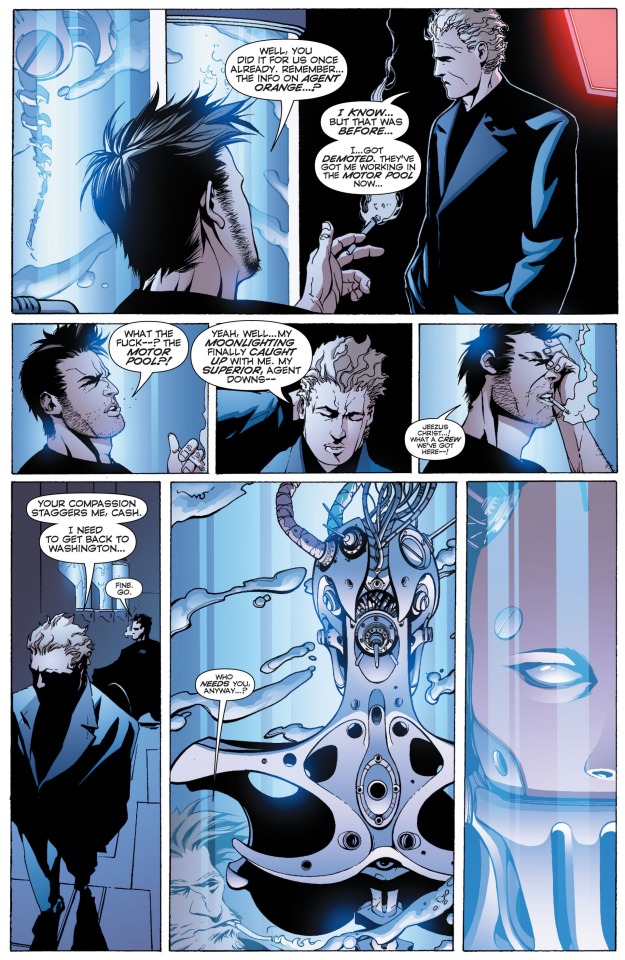
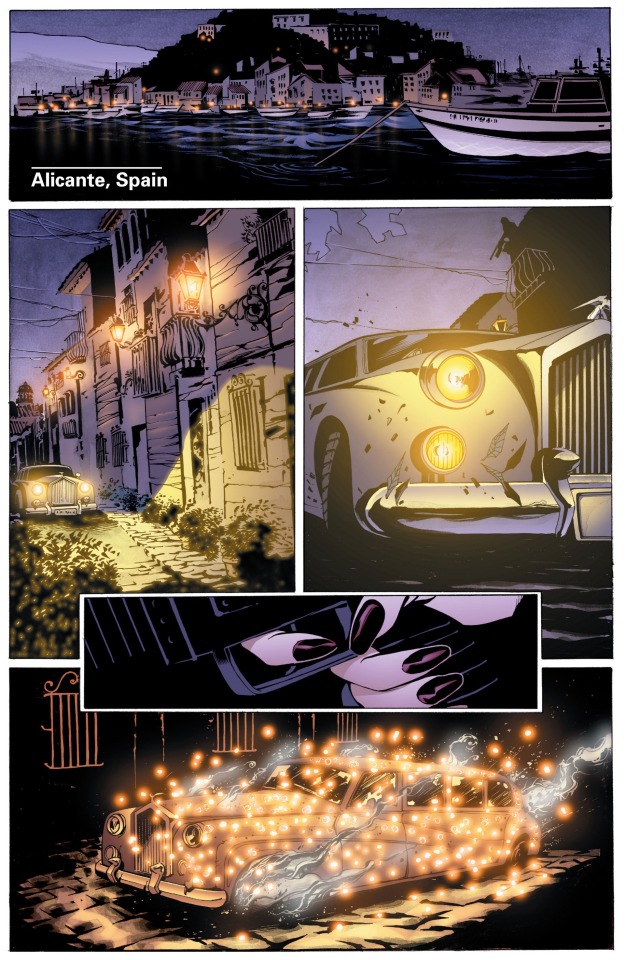


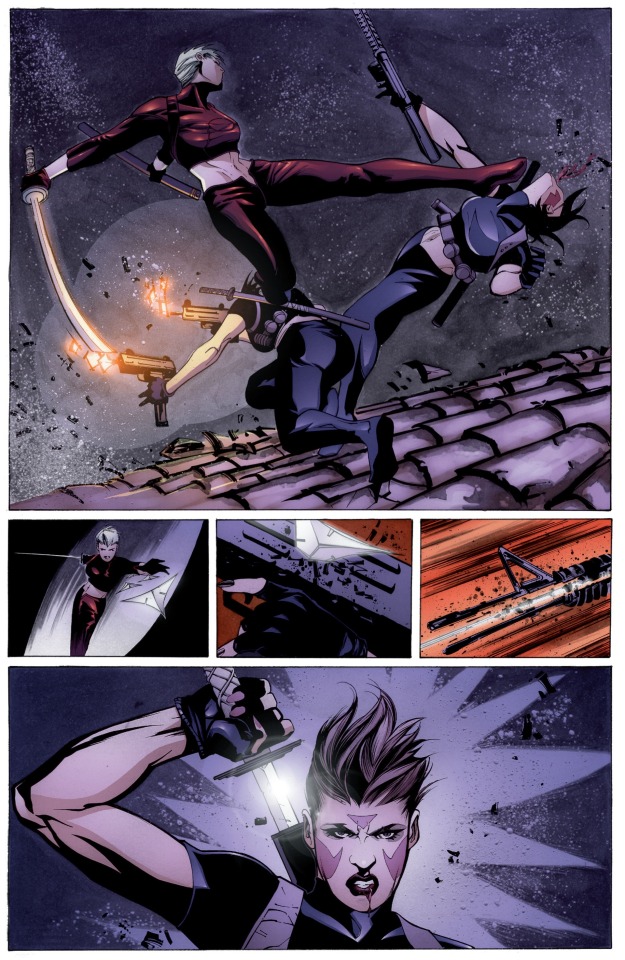
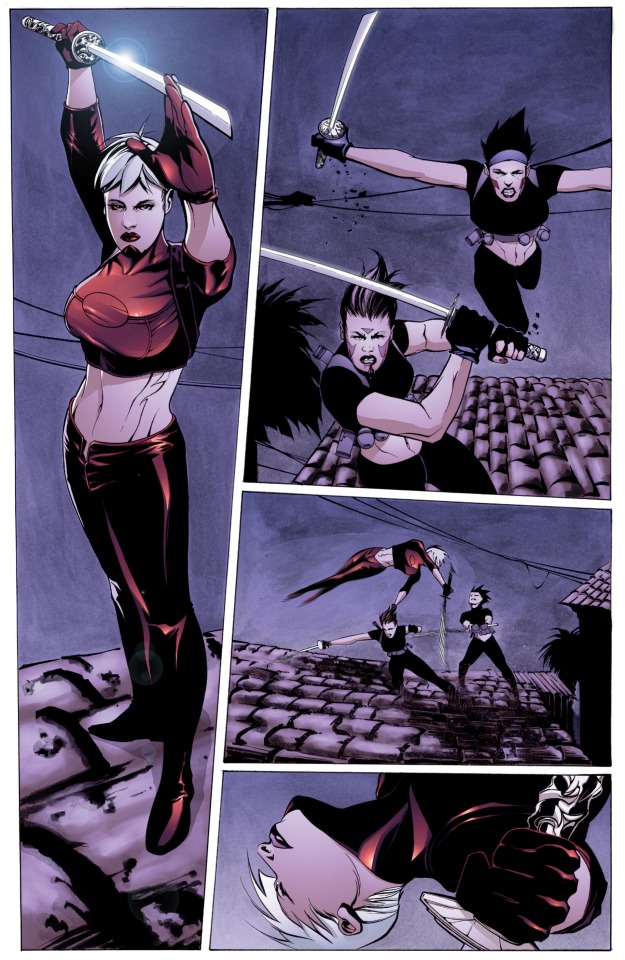

WildCATS Version 3.0 13 (2003) by Joe Casey & Dustin Nguyen
#WILDSTORM#WILDCATS#HALO INDUSTRIES#SPARTAN#GRIFTER#AGENT WAX#AGENT ORANGE#ZEALOT#JOE CASEY#DUSTIN NGUYEN
21 notes
·
View notes
Photo
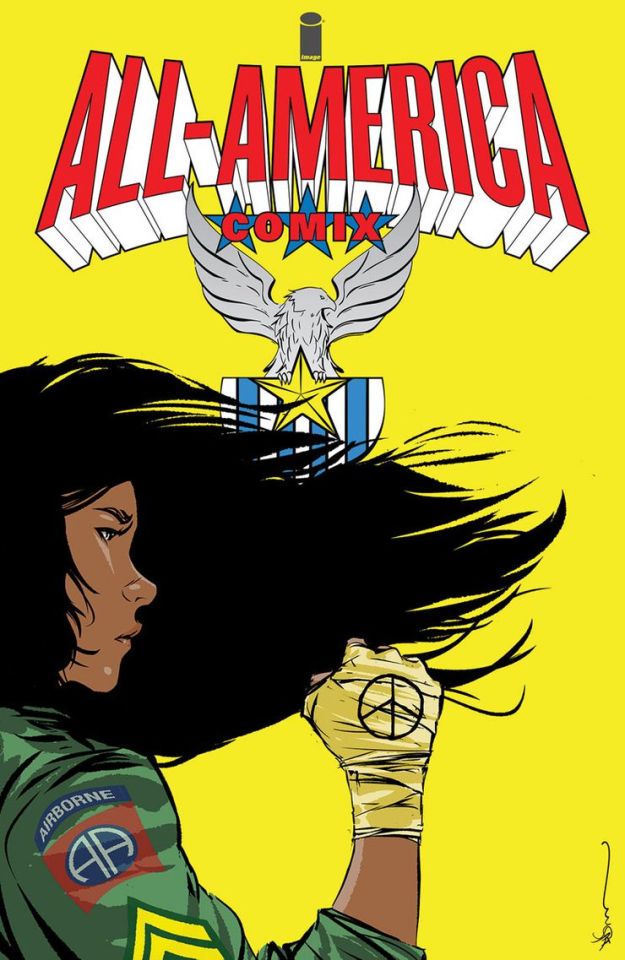
ALL-AMERICA COMIX #1 (ONE-SHOT)
WRITER: JOE CASEY
ARTIST: DUSTIN NGUYEN
COVER: DUSTIN NGUYEN & SONIA HARRIS
JUNE 17 / 32 PAGES / FC / T+ / $3.99
Her last name is VASQUEZ! Her first name…says it all! And when confronted with the hidden secret of the universe, you won’t believe the cosmic truth she uncovers! Brought to you by the Wildcats Version 3.0 team of JOE CASEY and DUSTIN NGUYEN—reunited for the first time in fifteen years!
1 note
·
View note
Text
"Chasing New Dawn" influences
As I shared Chasing New Dawn in various writing groups, I realized that the vast majority of people in those groups had no idea what tropes I was referencing, because they didn’t grow up on things like Sailor Moon and Power Rangers, or the teen dramas I watched and shojo manga I read. So, just for fun, I decided to put together some of the major influences. Some influences were more direct than others, and, in a lot of cases, it was more about being influenced by themes, aesthetics and world-building than any plot points or characters. And I’m well aware that several of the things on this list are a bit obscure (if not completely unknown) in the West - but then, I would be surprised if there’s anyone who would recognize everything atop of their heads.
In cases where there’s more than one version of a work (like a book and a TV adaptation). In cases like that, I listed it under whichever version I’m most familiar with/inspired by.
Anime and Cartoons
Clémentine
Code Geass
Digimon (mostly seasons 1-2)
Final Fantasy: Advent Children
Giant Robo: The Day the Earth Stood Still
Godzilla: the Series
Gundam Wing
Sailor Moon
Sym-Bionic Titan
Transformers:Masterforce
Vision of Escaflowne
X (the TV series)
Books
Airplane Named Seryozha By Vladislav Krapivin
Animorphs by K.A. Applegate
Genome trilogy by Sergey Lukyanenko
“In the Depths of the Great Crystal” series by Vladislav Krapivin
A Princess is Worth Dying For by Sergey Lukyanenko
The Reluctant King and its sequels by L. Sprague de Camp
“Watchers” series by Peter Lerangis
Comic books and Manga
Astro City by Kurt Busiek and Brent Anderson
Babel II by Mitsuteru Yokoyama
Danger Club by Landry Walker and Eric Jones
“Lost World” (a Planet Comics serial)
Majin Devil by Oh! Great
Miracleman by Alan Moore, Neil Gaiman and various artists
Neon Genesis Evangelion manga adaptation
Powers by Brian Michael Bendis and Michael Oeming
Scott Pilgrim by Brian O’Malley
Shadow Star/Narutaru by Mohiro Kitoh
Wildcats 3.0 by Joe Casey and
X-Day by Setona Mizushiro
X-Men
Zenith by Grant Morrison and Steve Yeowell
Live-Action
The Adventures of the Elektronic mini-series
Doctor Who (mostly Series 1-3 of the 2004 revival)
Kamen RIder franchise (especially the original series, Kamen RIder Kabuto and Kamen RIder Dragon Knight)
Lizzie McGuire
The Mystery Files of Shelby Woo
Power Rangers (especially Mighty Morphin Power Rangers, Power Rangers in Space, Power Rangers Dino Thunder and Power Rangers RPM seasons)
Super Sentai
Victorious
Zoey 101
Other
Channel Awesome meta
Persona 4-5
SCP Foundation
#CND Inspiration#CND Behind the Scenes#nickelodeon#animorphs#Giant Robo The Animation#Power Rangers#kamen rider#Zoey 101#victorious#astro city#В глубине великого кристалла#super sentai#Clémentine#CLAMP#hunt bowman
1 note
·
View note
Text
Agent Wax
“We’re taking over this investigation.” - Agent Wax

Gender: Male
Eyes: Blue
Hair: Blonde
Powers:
Hypnosis
Weaknesses:
Power Limitation
Universe: Wildstorm Universe
Citizenship: American
Marital Status: Married
Occupation:
Head of National Park Service
Agent
First Appearance: Wildcats #15 (November, 2000)
Last Appearance: Wildcats Version 3.0 #24 (October, 2004)

Powers
Hypnosis: Wax can mentally exert commands onto others temporarily and make them follow his orders.
Mind Control
Illusion Casting: Thanks to his hypnotic powers, Wax can project illusions into the minds of others, like appearing as another individual.
Memory Manipulation

Weaknesses
Power Limitation: The mental pushes are temporary along with the fact those affected can remember they've been hypnotized and must be constantly exerted to have long-term effects. However, they are ineffective on robotic entities.

History
Agent Wax was a field agent working for the National Park Service, a secret US government sponsored-group that monitored and responded to the activities of Super Powered Beings.
Unbeknownst to his organization or his boss, Agent Downs, Agent Wax was actually a SPB with the power of mental suggestion, a power he uncovered at the age of fifteen. According to Wax, he inherited his ability from his parents who kept their abilities secret from the world. However, he revealed that his parents possessed great animosity towards each other and possessed destructive powers which ended in his parents killing each other.
He first met the Wildcats when he was hunting a serial killing SPB named Sammy "Slaughterhouse" Smith that was seducing and killing young women with the surname "Marlowe" for the sake of luring and trying to kill Spartan. Spartan had Grifter kill the SPB and then he offered Agent Wax a job in which Wax kept an eye on the National Park Service and made sure they didn't investigate Spartan too much. He worked undercover as an employee of Spartan, which kept him out of the office and prevented him from doing his job so he got demoted to desk jockey and then a chauffeur for his boss' wife. As payback, Wax used his hypnotic powers to rape his boss's wife. Eventually, his boss found out and tried to kill him and his wife for the forced infidelity, but Wax made him kill himself instead and then used his hypnosis to make everyone in the National Park Service think he was the boss. This act allowed him to run the National Park Service and still work with Spartan.
It is unknown what happened to him after the World's End event that decimated most of the Earth's population, but considering he wasn't listed as one of the Earth's surviving superhumans by Spartan, it is assumed he perished.
1 note
·
View note
Text
Dustin Nguyen
Dustin Nguyen #bandasdesenhadas
BD² – Base de Dados de Banda Desenhada

Dustin Nguyen
Nascimento: 1976
Naturalidade: EUA
É um artista de banda desenhada best-seller dos EUA, conhecido por obras como Wildcats version 3.0, The Authority Revolution, Batman, Superman/Batman, Detective Comics, Batgirl e Batman: Streets of Gotham. Também foi coargumentista (e desenhador) de Justice League Beyond, ilustrou o volume American…
View On WordPress
0 notes
Text
2019’s projected 130-team S&P+ rankings, from Bama to UTEP

Here are the three pieces used to create these projections, along with some more notes at the bottom.
The preseason S&P+ projections are a simple mix of three factors: recent history, returning production, and recruiting. To come up with 130-team projections for all of FBS, I create projected ratings based on each factor. Here’s how the process works:
For recruiting, I create a rating based on these weighted four-year recruiting rankings. The weighting (67 percent this year’s class, 15 percent last year’s, 15 percent the year before that, three percent the year before that) is based on what makes the ratings most predictive.
For returning production, I take each team’s returning offensive and defensive production (which are on different scales) and apply projected changes to last year’s ratings. The ranking you see below is not where they rank in returning production but where they would rank after the projected changes are applied to last year’s S&P+ averages. This piece makes up a vast majority of the overall S&P+ projections.
For recent history, I’ve found that getting a little weird predicts pretty well. This number isn’t a strict five-year average — last year’s ratings already carry heavy weight from the returning production piece. Instead, what you see below is a projection based solely off of seasons two to five years ago. Recent history doesn’t carry much weight in the projections, but it serves as a reflection of overall program health. We overreact to one year’s performance sometimes.
Enough talk. Here are the preliminary projected S&P+ rankings for 2019.
Your projected conference leaders

Matthew Emmons-USA TODAY Sports
Clemson’s Trevor Lawrence
You can sort by each category above, but here are the top three projected teams in each conference:
AAC: No. 26 Memphis, No. 27 UCF, No. 44 Cincinnati
ACC: No. 3 Clemson, No. 19 Miami, No. 28 Florida State
Big 12: No. 5 Oklahoma, No. 22 Oklahoma State, No. 34 TCU
Big Ten: No. 7 Ohio State, No. 9 Michigan, No. 11 Wisconsin
Conference USA: No. 74 Southern Miss, No. 77 Marshall, No. 79 FAU
MAC: No. 75 WMU, No. 76 NIU, No. 78 Toledo
Mountain West: No. 24 Boise State, No. 42 Utah State, No. 51 Fresno State
Pac-12: No. 15 Washington, No. 17 Utah, No. 20 Oregon
SEC: No. 1 Alabama, No. 2 Georgia, No. 4 LSU
Sun Belt: No. 31 Appalachian State, No. 69 Troy, No. 70 Arkansas State
Projected conference averages
SEC (+18.1, down 0.5 from 2018)
Big Ten (+9.0, up 1.2)
Big 12 (+7.6, down 0.2)
Pac-12 (+7.2, up 1.1)
ACC (+6.6, up 1.3)
AAC (-3.0, same)
MWC (-3.1, down 2.3)
Sun Belt (-6.5, up 1.1)
MAC (-8.9, up 0.4)
Conference USA (-10.3, same)
In January I made revisions to the S&P+ algorithm, discussed here and elsewhere. One of a few tweaks was a conference-wide strength adjustment.
After the ratings are determined, I project previous games based on those ratings, and I track each conference’s average performance versus projection. For the top conference, I found that by the end of the season it was aiming low by two or three points per game per team. For the bottom conference, it was the reverse.
Shifting each team’s rating based on this conference average, and increasing the weight of said adjustment as the season progresses, basically improves against-the-spread performance by about 1 percentage point per season and cuts the average absolute error by somewhere between 0.2 and 0.3 points per game.
That doesn’t seem like much, but look at the Prediction Tracker results and note how much of a difference 1 percent and 0.3 points per game could make to your projective ranking there.
It does, however, mean a fundamental shift in how mid-major teams are judged.
For a given season, shifting each conference team in this manner can mean that the best conference in FBS ends up with quite a few teams near the top. For the 2008 season (as presented in the example above), that means a heavy Big 12 presence. And for 2018, it means that the SEC dominated the ratings as much as any conference ever has — as much as SEC fans like to think their league dominates every year.
In the adjusted S&P+ rankings for 2018, SEC teams occupied six of the top nine spots in the rankings. That’s ... significant ... but transitively, it ties together pretty well. No. 1 Alabama’s only loss came to No. 3 Clemson (with wins over five other top-10 teams); two of No. 2 Georgia’s three losses came to teams in the top five; No. 5 LSU lost only to the No. 1, No. 9, and No. 11 teams while beating No. 7, No. 8, and No. 18; etc.
(This adjustment also means that national champion Clemson now ranks third instead of second. That’s awkward, but again, the conference-level adjustment makes S&P+ more accurately predictive overall. Nothing’s going to fit perfectly with our perceptions.)
So if the SEC was easily the best-graded conference in 2018 — far better than it had in any season since 2014 — and only a couple of league teams are on the bad side of the returning production measure, there’s probably no reason to think it will be projected much lower in 2019. And I would figure “10 teams in the top 21” qualifies as “not projected lower.”
What about unit rankings?

Marvin Gentry-USA TODAY Sports
Alabama’s Dylan Moses
Here are the same S&P+ projections, only with projected offensive and defensive ratings included.
Easily the most interesting tidbit to me here: Alabama’s defense projects 10th overall ... and just fifth in the SEC. After a down year by Bama standards (the Tide were seventh in Def. S&P+), Nick Saban’s squad now has to again replace most of its difference-makers. It’s easy to assume a rebound — Bama hadn’t finished lower than fourth in Def. S&P+ since 2010 and had finished first for four years running — but Saban will need quite a few new starters to play like All-Americans. Lord knows it’s happened before.
(Even with this merely awesome, but not historically amazing, defense, Bama still ranks an easy first overall thanks to an offense that is as loaded at the skill positions as any Bama offense ever has been.)
Stats vs. conventional wisdom
It’s pretty clear at the end of one season who will be picked atop the rankings for the next. In most Way Too Early Top 25s for 2019, Clemson is a virtually unanimous No. 1, Alabama a unanimous No. 2, and Georgia a unanimous No. 3. Ohio State, Oklahoma, and Notre Dame make up spots 4-6 in some order, and some combination of Florida, Texas, LSU, Michigan, and Oregon rounds out the top 10.
Texas A&M, Washington, and Penn State are is most top-15s, and Utah, Wisconsin, Iowa State, and Northwestern are in or near the top 20.
S&P+ doesn’t disagree much at the top, even if there’s a slightly different order (Clemson’s third).
It thinks more highly of LSU (fourth versus a consensus of about ninth), and it doesn’t punish Auburn for always having a ridiculous schedule — the Tigers are projected eighth as opposed to the Way Too Early consensus of something around 23rd. It values another set of SEC Tigers (Missouri) more highly, too, and it’s more bullish on a couple of Big Ten teams as well (Wisconsin and Michigan State).
As a whole, though, advanced stats are a lot more useful in judging who’s overvalued than who’s undervalued.
S&P+ didn’t think highly of Northwestern (68th in 2018) or Syracuse (40th) despite nice win totals, and it doesn’t see much reason to change its mind in 2019 — when the Wildcats are projected 57th, the Orange 56th.
It also suggests we tap the brakes on Nebraska. The Huskers are projected 45th but are receiving plenty of top-25 votes from the humans.
Perhaps the most noteworthy disagreement between humans and this computer:
Texas is 35th???

Derick E. Hingle-USA TODAY Sports
Tom Herman
In 2015, Tom Herman’s Houston Cougars enjoyed a magical run. They went 13-1, rolled to the AAC title, and beat Florida State in the Peach Bowl. The numbers were unimpressed. UH ranked just 53rd in (the updated version of) S&P+, looking more like a 10-4 team on paper and propped up by five points per game of good turnovers luck.
In Houston’s 2016 preview, I wrote this:
Houston is going to be good. In 2016, something like a 9-3 record would be considered disappointing. This scenario plays out a lot in this sport, and it shouldn’t a surprise that it’s what the skeptical S&P+ ratings are projecting.
Houston improved to 39th in S&P+ ... and went 9-3. You can defy the numbers once, but it’s really hard to do it twice in a row.
Herman’s team might have something familiar going on heading into 2019.
In 2018, another Herman team defied both expectation and statistics. In his second year at Texas, his Longhorns ranked 32nd in S&P+ and, per second-order wins, had the look of an eight-win team. For every strong performance (namely, wins over Oklahoma and Georgia), there was a dud or near-disaster — a loss to Maryland, near-losses to Tulsa, Baylor, Texas Tech, Kansas, etc. Against anyone but the top teams, they did the bare minimum; it bit them once and nearly did so many other times.
Still, they won 10 games, finishing with a win over a depleted but talented UGA in the Sugar Bowl. From that point forward, they were all but guaranteed to find a spot in everyone’s preseason top 10.
The final piece of the puzzle for Herman in Austin might not be filling in holes on the two-deep. It will be figuring out how to field a team that plays every game like the Sugar Bowl.
S&P+ doesn’t tend to trust teams that perform so inconsistently. Plus, Texas must replace a higher percentage of last year’s production than any other power conference team.
The Horns bring back quarterback Sam Ehlinger and receiver Collin Johnson as headliners, plus the fruits of successful recruiting.
They do not, however, return their leading rusher (Tre Watson), leading receiver (Lil’Jordan Humphrey), three honorable mention all-conference offensive linemen, their top three tacklers on the defensive line, their top two linebackers, and three of their top five defensive backs, including corner Kris Boyd, who led the team in havoc plays (tackles for loss, forced fumbles, and passes defensed).
Herman has signed two straight dynamite classes, and his Horns have what appears to be a manageable schedule for a top-10 team, if they can get by LSU at home. But they’ve got a lot of churn to overcome, and they used a lot of good fortune last year.
S&P+ is going to project them to win about seven games. A Herman team has defied stats a couple of times now, but they haven’t yet done it back-to-back.
OK, there might be one more team that stands out:
Tennessee is 21st???

Dale Zanine-USA TODAY Sports
Tennessee’s Josh Palmer (84) and Ty Chandler (8)
Jeremy Pruitt’s Vols might have more going for them than we realized.
For starters, Pruitt has recruited well. According to the 247Sports Composite, he inked the No. 21 class in FBS in 2018, then one-upped himself and signed the No. 12 class this year, despite what we’ll politely call a lack of proof on the field. Granted, recruiting has never been a problem in Knoxville, but ...
The Vols were crazy-young in 2018. They return more of last year’s production than any P5 team, and it would defy recent history if they weren’t to improve by at least a few points per game.
S&P+ projections are primarily made up of returning production and recent recruiting; Tennessee looks awfully good in both of those areas and therefore gets a potential boost.
There’s an obvious parallel: Georgia was mediocre in Kirby Smart’s first year, then paired heavy returning production with great recruiting to enjoy a major second-year breakthrough in 2017.
Tennessee is starting from a lot further behind. I’m doubting there’s a run to the national title game in the works. Still, Pruitt and his coaches have vastly more to work with in 2019.
0 notes
Note
Hi Chad - I quite like making bound volumes of comics. It definitely makes me more likely to read them again and they look great on the shelves. My question, thinking of your Thor newsletter, is if you were doing a complete Marvel Jason Aaron bind (or Bendis if you prefer) how would you break it down into volumes? Thanks, David.
An unexpected question...
I guess it depends on how big they can be... I'm not sure either writer works for me entirely, because I don't have either's COMPLETE works at Marvel. But, I guess it's a matter of how best to order things, especially when runs overlap in release schedules... It's not dissimilar from my love of doing reading orders -- but that's usually much more focused, narrowing in a specific title/group of titles that share some sort of story connections. With Jason Aaron, for example, how do you put the Thor and Dr. Strange next to each other? Hell, the latter began during the currect volume of the former. Do you intersperse them? (NO!) Do you just slot Dr. Strange between Thors and The Mighty Thor? (Maybe...) Another way to do it is to think somewhat like a literary multi-volume collection where the type of comic might determine things. So you group his X-Men books or even given big runs their own volume(s) while shorter work is put together into its own section. I guess it depends on the type of writer. A lot of the recent-ish Marvel guys, like Bendis, Aaron, and Jonathan Hickman would be hard to do that last type of collection with, because they have a habit of building on what came before. You almost need to do a big reading order and just collect things that way, jumping between books from story to story.
Now, a guy like Joe Casey would be fun to do a big library multi-volume collection for. Off the top of my head, here's what I would do (assuming you could fit everything in these volumes -- otherwise, divide up as needed -- like, the Wildcats/Wildcats Version 3.0 volume could easily be the two separated)
Vol. 1: Cable, Incredible Hulk, Deathlok, Last Defenders, Zodiac, and VengeanceVol. 2: Wildcats and Wildcats Version 3.0Vol. 3: Uncanny X-Men and Adventures of Superman up to the final yearVol. 3: Mr. Majestic, the final year of Adventures of SupermanVol. 4: The Nostalgia Stuff (Children of the Atom, First Family, Earth's Mightiest Heroes 1 and 2, Enter the Mandarin)Vol. 5: GI Joe and KissVol. 6: Automatic Kafka, the Intimates, and YoungbloodVol. 7: Codeflesh, Rock Bottom, the Milkman Murders Nixon's Pals, Charlatan Ball, Officer Downe, Doc Bizarre MD, Catalyst Comix, Bounce, and Butcher Baker the Righteous MakerVol. 8: GodlandVol. 9: Haunt, Captain Victory, Marijuanaman, and Miami Vice Remix
And so on... I got bored (and, actually, those final few volumes could have been split better). But, near the end would be the volumes collection the random one-offs he wrote like Batman: Tenses and that hippie Gen13 comic and the Gen13 wrestling comic and Velocity #1. I think Casey's work lends itself to that sort of collecting, because he never really stuck around anywhere long enough to continually build on what came before (aside from some of that early Marvel work when it seemed like he would make a go of it there longterm). Warren Ellis and Garth Ennis could be done similarly. Maybe Grant Morrison?
It's not quite as easy as it is with other writers where novels, short stories, plays, poetry, essays, nonfiction books, etc. all make for easy divisions. With comics, it seems like you have big runs, short runs, superhero work, nonsuperhero work -- and that's before you get into which company the superhero work was done for!
I don't think I gave you the sort of answer you were looking for.
2 notes
·
View notes
Text
Wildcats Version 3.0 #1

#comics#comic books#wildstorm#wildcats#WildC.A.T.s#grifter#jack marlowe#wildcats 3.0#eye of the storm#Joe casey#Dustin Nguyen
0 notes
Photo



WildCATS Version 3.0 16 (2004) by Joe Casey & Dustin Nguyen
#WILDSTORM#WILDCATS#HALO INDUSTRIES#SPARTAN#GRIFTER#AGENT WAX#ZEALOT#LADYTRON#JOE CASEY#DUSTIN NGUYEN
11 notes
·
View notes
Photo

I’m not really an expert on the Wildstorm universe, which was essentially Jim Lee’s section of Image Comics when it was founded, before becoming a DC Comics imprint and then eventually being shut down (which led to Alan Moore’s America’s Best Comics ceasing to be, as he could work with DC at one step removed via the imprint, but not directly with the publisher), with many of the original Wildstorm characters being folded into the DC Universe as part of The New 52 reboot.
Most of my experience of it has been connected to writers, starting with Warren Ellis on The Authority (and then back to his run on Stormwatch), then Joe Casey on Wildcats and Wildcats Version 3.0 (and then back to Alan Moore and James Robinson writing WildC.A.T.S.), and probably a few others here and there. And so I recognise a lot of the players here, but I’m buying this for the creative team, just like before, not out of any loyalty to the characters.
Thus I can’t judge what the reaction would be from someone who is fan of the Wildstorm universe, but I enjoy the fact that, unlike any DC Universe Rebirth story, this isn’t about previous continuity and picking and choosing what is canon. Ellis has made clear in promotional interviews that this is a clean slate, and then the first nine panel page clearly symbolises this for anyone that remembers the characters.
Here, you can see red markings on the character’s face, very similar to the original character design of Zealot. As she washes blood from her hands, and the scene around her becomes clearer, she calls in a report, confirming that she is Zealot (or that’s her call sign at least). In the last two panels, the markings on her face are being wiped off as well, confirming it was just more blood, albeit in coincidental splatter pattern. And just like that, the slate is wiped clean and we are in a new universe where we can see familiar pieces being moved across a completely different board, presumably selected either because of Ellis’s fondness for the character (which I imagine is the case with Angie Spica, The Authority’s Engineer) or because they suit his themes, whatever they turn out to be. ‘The Future’ is certainly likely to be a part of it, given his constant interest in that subject, and- as seen in Wildcats Version 3.0- the Halo Corporation is a good creation with which to explore that.
Conspiracy theory and extraterrestrials are referenced in the promo materials, and are another popular Ellis subject as well as ingredients in the original concept (where the backdrop was a centuries old war between two alien races), making the decision to allow the whole Wildstorm universe to be started over by this particular writer a very appropriate one (aside from his general lack of interests in superheroes, but I think it’s safe to DC knew about that. It’s hardly a secret, so they must have accepted they were unlikely to get primary coloured morality lessons or a return to the ridiculously excessive 90s costumes of the characters’ early days).
It’s doubtful that The Wild Storm will reach the commercial heights of The Authority, given the current state of the market and the story being told, but it feels likely to be another tour de force in story telling across its 24 issues. The Authority had a great, long-lasting, impact on the form- widescreen, decompression, etc. all became buzzwords following its success, although they were rarely used with anything like the skill of Ellis, all too often used because they looked cool rather than being useful storytelling tools, resulting in some very hollow stories that thought they understood what made the Ellis book popular.
This comic has a completely different set of storytelling skills in play- there’s probably more panels in this first issue than there is in a story arc of The Authority!- showing that the creative team know how to use the form to tell the story they want to tell, rather than be beholden to some sort of ‘Wildstorm style’. Ellis is not a writer to just revisit his greatest hits when he can challenge himself and the medium, thus where The Authority was widescreen, The Wild Storm is claustrophobic, a markedly different creature, despite the shared roots of both titles, because the form needs to reflect the thematic concerns to create a successful story. Although The Wild Storm has only begun, and there is more to come in terms of related titles, I think it safe to say that this is likely to be a (at least creatively) very successful relaunch.
From The Wild Storm 1, by Warren Ellis, Jon Davis-Hunt & Ivan Plascencia
0 notes
Text
In The Wild Storm, Warren Ellis Takes Hold of a Universe
This article contains spoilers for “The Wild Storm” #1, in stores now.
Wildstorm has gone through some ups and downs in the 25 years since its debut as artist Jim Lee’s corner of the upstart publisher Image Comics, and for most of the last decade or more, the needle has largely pointed southward. Now a part of the DC Comics family (with Lee a DC co-publisher), the heroes of “WildC.A.T.S.” and “Stormwatch” have, in recent years, struggled to find an audience. Even “The Authority,” launched to acclaim by Warren Ellis and Bryan Hitch before Mark Millar took over for another successful run, has failed to catch on in its last few series. With “The Wild Storm,” DC turns once again to Warren Ellis to harness the esoteric quality that has been essential to the WildStorm universe’s greatest successes: innovation, and doing the unexpected.
One can view DC’s previous missteps with WildStorm as a misunderstanding of what makes these comics connect with readers. In the early days, it was the art, with Lee’s “WildC.A.T.S.” and J. Scott Campbell’s “Gen13” being clear standouts. Beginning in the late ’90s with “The Authority” and “Wildcats Version 3.0,” it was a strong concept, expertly executed. It’s never been primarily about the characters. There are certainly Zealot zealots out there, but moving characters like Grifter and Deathblow to the prime DC universe largely neuters their effect by making them one among many rather than characters with a particular role to play. Even Midnighter, perhaps Wildstorm’s most popular character, failed to find his footing until writer Steve Orlando recently carved out a unique place for him within the DCU.
What Ellis understands about the WildStorm universe is that it is best used to explore contemporary fears, hopes, and anxieties. At the turn of the millennium, he gave us Jenny Sparks; now he’s giving us something else.
Zealot comes out of a difficult interview
Ellis and artist Jon Davis-Hunt’s first issue of “The Wild Storm” re-introduces several major players and places them in their new context. Zealot, also known as Lucy Blaze, is an intelligence agent who’s just completed an “interview [that] went badly;” in other words, she had to kill her target, a fellow gene-hacking his own body. Priscilla Kitaen is launching an album and insists on targeting a specific set of NYC billboards, due to the area’s mythic and UFO significance; she is also known as Voodoo, which another character calls out as problematic. Angela Spica emerges as a damaged researcher able to manifest full-body armor. But the prime conflict appears to be between International Operations, more commonly known as IO and led by Miles Craven, and Jacob Marlowe’s HALO Corp. Two tech giants molding culture, each harboring deep secrets. Marlowe, who so far appears benevolent, is a centuries-old alien being of immense power, while Craven employs superpowered assassins to remove his rivals.
There are affinities to the old continuity, clearly — is Marlowe the Kherubim Lord Emp? Will Michael Cray, who collapses at the end of the issue, become Deathblow to right his wrongs before a brain tumor claims his life? Is an alien race called the Daemonites operating somewhere below the surface of society? After the first issue, none of this is clear; but more importantly, it’s beside the point. Ellis is picking and choosing the elements that will best help to re-establish a WildStorm universe that can effectively interrogate our own world. Angie’s Engineer, far from the sleek heroine whose body is fluidly enveloped in liquid metal, instead undergoes a brutal, mechanical transformation, acknowledging that the beauty and wonder of technological progress has given way to skepticism and horror at its costs; even as Angie pleads for funding to continue her research, the reader can see the immense toll her devotion has taken on her mental state. A researcher for IO, she saves the life of her boss’s rival. And as the world at large wonders about the sudden appearance of the metal woman, Miles Craven has already identified her by making efficient use of surveillance culture. Our modern paranoia is both more subtle and more desperate; we know about the secret forces running the world, we can name them, and we play the game anyway.
The Engineer and Marlowe
This underlying tone makes Davis-Hunt an excellent choice for series artist. His art is stylish without being overly stylized, and the muted palette of colorist Ivan Plascencia grounds this story in the real world. The modified six- and nine-panel grids create an even, natural, almost leisurely pace for the first third of the book, such that when tiers split for Angie’s transformation it’s almost an act of violence.
A creator of Ellis’ caliber does not necessarily ensure the success of a new WildStorm. After all, the imprint has seen some of comics’ best writers tackle these heroes, going back to the Image Comics days; James Robinson wrote “WildC.A.T.S.,” as did Alan Moore, but DC barely bothers to keep the “Watchmen” author’s WildStorm omnibus in print. But Ellis, a creator who is perhaps only second to Jim Lee in his association with the line, has shown an affinity for using this universe; he sees how the pieces fit together, and crafts new pieces only to suit his needs. He brings the thrill of the unexpected; his run on “Stormwatch” ended with the death of most of the original line-up in an inter-company crossover. And from those ashes he created “The Authority,” full of archetypal characters playing their parts in a widescreen drama embodying the era. That’s why Ellis writing “The Wild Storm” and overseeing the relaunch is exciting; that’s why he is primed to succeed in a way that even Grant Morrison, whose “Authority” and “WildC.A.T.S.” reboots crashed out of the gate, was not.
“The Wild Storm” #1 is certainly what you’d want from Warren Ellis remodeling a universe. It’s witty, it’s intelligent, it has folks getting pushed out windows. There is, already, a sense of grand strategy and design, and it’s hard not to sympathize with the heroes about to get swept up into it. But we’re ready to be swept up, as well.
The post In The Wild Storm, Warren Ellis Takes Hold of a Universe appeared first on CBR.com.
http://ift.tt/2lmTYwl
0 notes
Text
Ranking college football’s Week 11 final scores by surprising-ness

Statis at the top, party at the bottom. The college football season’s strange personality continued.
Georgia could beat Alabama. Ohio State could beat Michigan. Pitt could beat Clemson (the Panthers have done it before, anyway). Things could still get weird at the top of the college football landscape.
That said, it’s pretty clear how the 2018 season has defined itself: total stasis at the top, total chaos everywhere else. Week 11 was maybe the most heavily distilled version of this yet: nobody in the top 10 lost, and the projected College Football Playoff didn’t change at all.
Beneath the surface, though, oddity reigned. Northwestern clinched the Big Ten West, despite an 0-3 non-conference record, with an upset of Iowa (and with Minnesota’s sudden and total destruction of Purdue). Pitt moved closer to the ACC Coastal title despite a 6-4 record. The Pac-12 South remained extraordinarily messy. There are always total surprises in this ridiculous sport; it’s just that in some years you have to search a little harder to find them.
Let’s look back at Week 11 action by looking at the difference between projection and reality. S&P+ had a pretty good week — great from an absolute error standpoint (the difference between projection and result), though an only decent 53 percent against the spread. But whether the numbers are dialed in or not, however, there are always surprises.
Using the S&P+ projections as a guide, let’s look at which games played out as expected and which ones very, very much did not.
(Rankings listed below are from the most recent CFP rankings.)
Right on (projection and reality within 3 points of each other)

Photo by Wesley Hitt/Getty Images
LSU’s Clyde Edwards-Helaire
FAU 34, WKU 15 (projected margin: FAU by 18.9)
Iowa State 28, Baylor 14 (projected margin: ISU by 13.1)
Clemson 27, Boston College 7 (projected margin: Clemson by 18.4)
UL-Lafayette 36, Georgia State 22 (projected margin: UL by 12.4)
Virginia 45, Liberty 24 (projected margin: UVA by 19.2)
Utah State 62, SJSU 24 (projected margin: USU by 35.8)
Indiana 34, Maryland 32 (projected margin: UM by 0.6)
Middle Tennessee 48, UTEP 32 (projected margin: MTSU by 13.4)
LSU 24, Arkansas 17 (projected margin: LSU by 9.9)
Things got strange in Fayetteville toward the end, but the the overall result wasn’t that disappointing for LSU.
Mostly on (3 to 7 points)

Photo by Steven Branscombe/Getty Images
Nebraska’s JD Spielman
Nebraska 54, Illinois 35 (projected margin: NU by 15.7)
Miami (Ohio) 30, Ohio 28 (projected margin: Ohio by 1.3)
Cincinnati 35, USF 23 (projected margin: Cincy by 8.2)
Georgia 27, Auburn 10 (projected margin: UGA by 12.9)
EMU 27, Akron 7 (projected margin: EMU by 15.9)
Utah 32, Oregon 25 (projected margin: Utah by 11.2)
Stanford 48, Oregon State 17 (projected margin: Stanford by 26.7)
Florida 35, South Carolina 31 (projected margin: UF by 8.8)
Marshall 30, Charlotte 13 (projected margin: Herd by 22.2)
Tulane 24, ECU 18 (projected margin: Tulane by 11.8)
Notre Dame 42, Florida State 13 (projected margin: ND by 22.9)
Alabama 24, Mississippi State 0 (projected margin: Bama by 17.8)
Texas A&M 38, Ole Miss 24 (projected margin: A&M by 7.7)
Kansas State 21, Kansas 17 (projected margin: KSU by 10.7)
Michigan 42, Rutgers 7 (projected margin: UM by 41.9)
On Podcast Ain’t Played Nobody this week, I talked about how underrated-ly fun the Nebraska-Illinois game could be, with a surging NU offense and a gorgeous Illinois run game (and two bad defenses). Eighty-nine points and 1,100 yards later, I will claim victory on that one.
A little off (7 to 17 points)

Photo by Matthew Holst/Getty Images
Northwestern’s Clayton Thorson
SMU 62, UConn 50 (projected margin: SMU by 19.5)
Louisiana Tech 28, Rice 13 (projected margin: Tech by 23.4)
Duke 42, North Carolina 35 (projected margin: Duke by 15.6)
UAB 26, Southern Miss 23 (projected margin: UAB by 11.9)
Air Force 42, New Mexico 24 (projected margin: AFA by 8.7)
Cal 15, USC 14 (projected margin: USC by 8.4)
Penn State 22, Wisconsin 10 (projected margin: PSU by 2.5)
Appalachian State 38, Texas State 7 (projected margin: App State by 21.3)
Memphis 47, Tulsa 21 (projected margin: UM by 16.2)
Arizona State 31, UCLA 28 (projected margin: ASU by 13.1)
Missouri 33, Vanderbilt 28 (projected margin: Mizzou by 15.5)
Buffalo 48, Kent State 14 (projected margin: UB by 10.6)
Texas 41, Texas Tech 34 (projected margin: Tech by 3.9)
Army 31, Lafayette 13 (projected margin: Army by 29.3)
BYU 35, UMass 16 (projected margin: BYU by 7.2)
Troy 35, Georgia Southern 21 (projected margin: Troy by 2.1)
Georgia Tech 27, Miami 21 (projected margin: Canes by 6.7)
Temple 59, Houston 49 (projected margin: UH by 3.0)
Washington State 31, Colorado 7 (projected margin: Wazzu by 11.0)
Syracuse 54, Louisville 23 (projected margin: Cuse by 16.4)
Ohio State 26, Michigan State 6 (projected margin: OSU by 5.1)
Oklahoma 48, Oklahoma State 27 (projected margin: OU by 16.5)
Boise State 24, Fresno State 17 (projected margin: Fresno by 8.7)
Northwestern 14, Iowa 10 (projected margin: Iowa by 11.9)
From a numbers standpoint, Northwestern’s run of success this year is unfathomable. The Wildcats get outgained constantly, lost to Akron, etc. But they might also have the strongest identity in the country. They know how they’re going to win games, and it’s won them their first division title.
Way off (17-28 points)

Photo by Kent Horner/Getty Images
UNLV’s Lexington Thomas
Wake Forest 27, NC State 23 (projected margin: NC State by 13.1)
Arkansas State 44, Coastal Carolina (projected margin: ASU by 9.9)
UCF 35, Navy 24 (projected margin: UCF by 33.4)
NIU 38, Toledo 15 (projected margin: NIU by 0.1)
Old Dominion 34, North Texas (projected margin: UNT by 20.3)
ULM 38, South Alabama 10 (projected margin: ULM by 4.5)
Tennessee 24, Kentucky 7 (projected margin: UK by 7.3)
Nevada 49, Colorado State 10 (projected margin: Nevada by 14.6)
WVU 47, TCU 10 (projected margin: WVU by 10.4)
FIU 45, UTSA 7 (projected margin: FIU by 11.4)
UNLV 27, SDSU 24 (projected margin: SDSU by 24.1)
S&P+ missed high on UNLV for weeks because it takes a while to account for important injuries (like that of UNLV quarterback Armani Rogers). And then the moment it gives up on the Rebels, they pull a significant upset. Figures.
Way, way off (more than 28 points)

Photo by Hannah Foslien/Getty Images
Minnesota’s Jake Paulson
Pitt 52, Virginia Tech 22 (projected margin: VT by 0.3)
Minnesota 41, Purdue 10 (projected margin: Purdue by 8.4)
What the hell was that, Purdue??
0 notes